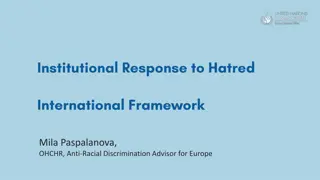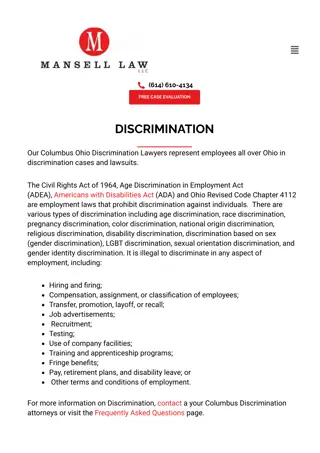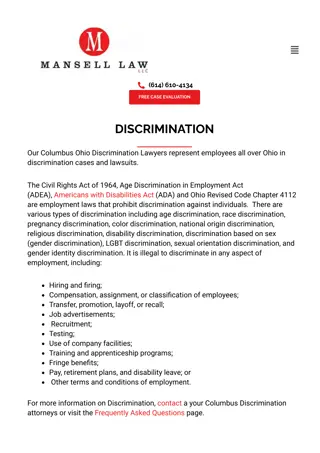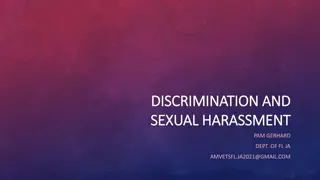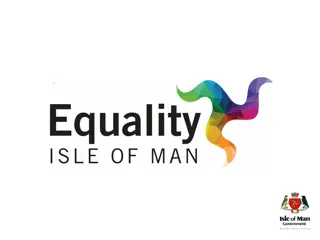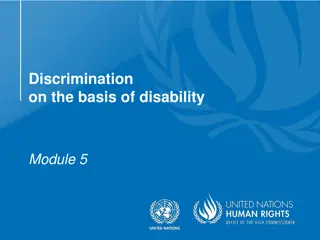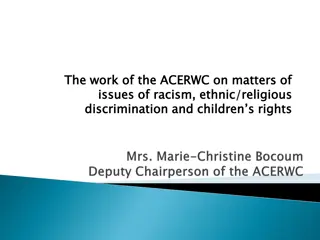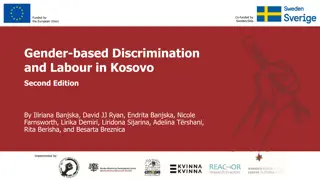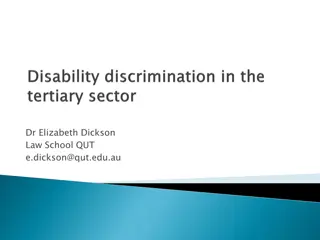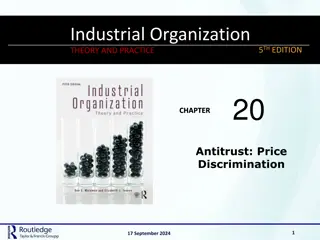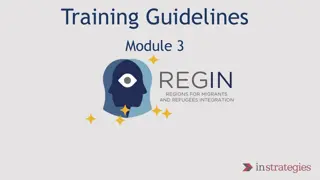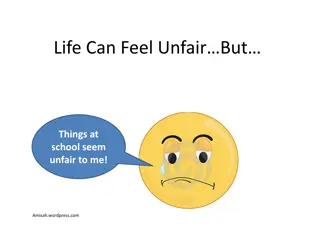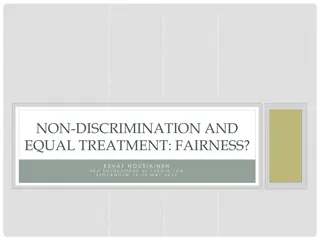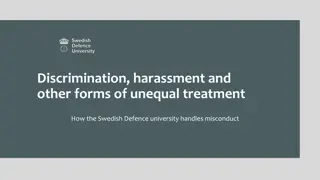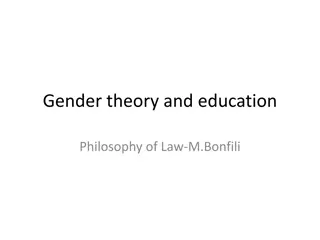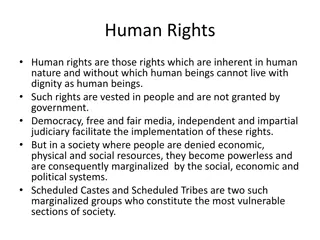Measures of Unfairness and Mechanisms to Mitigate Discrimination
In this talk, the concept of discrimination is explored from a computational perspective, addressing salient social groups, relative disadvantage, wrongful decisions, and more. Learn about the measures and mechanisms to combat discrimination.
Download Presentation

Please find below an Image/Link to download the presentation.
The content on the website is provided AS IS for your information and personal use only. It may not be sold, licensed, or shared on other websites without obtaining consent from the author.If you encounter any issues during the download, it is possible that the publisher has removed the file from their server.
You are allowed to download the files provided on this website for personal or commercial use, subject to the condition that they are used lawfully. All files are the property of their respective owners.
The content on the website is provided AS IS for your information and personal use only. It may not be sold, licensed, or shared on other websites without obtaining consent from the author.
E N D
Presentation Transcript
Measures of Unfairness, & Mechanisms to Mitigate Unfairness Krishna P. Gummadi Joint work with Muhammad Bilal Zafar, Isabel Valera, Manuel Gomez-Rodriguez Max Planck Institute for Software Systems
Context: Machine decision making Data-driven algorithmic decision making By learning over data about past decisions To assist or replace human decision making Increasingly being used in several domains Recruiting: Screening job applications Banking: Credit ratings / loan approvals Judiciary: Recidivism risk assessments Journalism: News recommender systems
This talk: Fairness in decision making Discrimination: A special type of unfairness Measures of discrimination Mechanisms to mitigate discrimination Unfairness beyond discrimination
This talk: Fairness in decision making Discrimination: A special type of unfairness Measures of discrimination Mechanisms to mitigate discrimination Unfairness beyond discrimination
The concept of discrimination Well-studied in social sciences Political science Moral philosophy Economics Law Majority of countries have anti-discrimination laws Discrimination recognized in several international human rights laws But, less-studied from a computational perspective
The concept of discrimination A first approximate normative / moralized definition: wrongfully impose a relative disadvantage on persons based on their membership in some salient social group e.g., race or gender
The devil is in the details What constitutes a salient social group? A question for political and social scientists What constitutes relative disadvantage? A question for economists and lawyers What constitutes a wrongful decision? A question for moral-philosophers What constitutes based on? A question for computer scientists
Discrimination: A computational perspective Consider binary classification using user attributes A1 A2 Am Decision User1 x1,1 x2,1 x3,1 xn,1 x1,2 x1,m x2,m x3,m xn,m Accept Reject Reject Accept User2 User3 Usern xn,2
Discrimination: A computational perspective Consider binary classification using user attributes SA1 NSA2 NSAm Decision User1 x1,1 x2,1 x3,1 xn,1 x1,2 x1,m x2,m x3,m xn,m Accept Reject Reject Accept User2 User3 Usern xn,2 Some attributes are sensitive, others non-sensitive
Discrimination: A computational perspective Consider binary classification using user attributes SA1 NSA2 NSAm Decision User1 x1,1 x2,1 x3,1 xn,1 x1,2 x1,m x2,m x3,m xn,m Accept Reject Reject Accept User2 User3 Usern xn,2 Some attributes are sensitive, others non-sensitive Decisions should not be based on sensitive attributes!
What constitutes not based on? Most intuitive notion: Ignore sensitive attributes Fairness through blindness or veil of ignorance When learning, strip sensitive attributes from inputs Avoids disparate treatment Same treatment for users with same non-sensitive attributes Irrespective of their sensitive attribute values Situational testing for discrimination discovery checks for this condition
Two problems with the intuitive notion Unless users of different sensitive attribute groups have similar non-sensitive feature distributions, we risk Disparate Mistreatment When global risk (loss) minimization during learning results in different levels of risks for different sensitive attribute groups 1. Disparate Impact When labels in training data are biased due to past discrimination 2.
Background: Learning 101 To learn, we define & optimize a risk (loss) function Over all examples in training data Risk function captures inaccuracy in prediction So learning is cast as an optimization problem For efficient learning (optimization) We define loss functions so that they are convex
Origins of disparate mistreatment SA1 NSA2 NSAm Decision User1 x1,1 x2,1 x3,1 xn,1 x1,2 x1,m x2,m x3,m xn,m Accept Reject Reject Accept User2 User3 Usern xn,2
Origins of disparate mistreatment SA1 NSA2 NSAm Decision User1 x1,1 x2,1 x3,1 xn,1 x1,2 x1,m x2,m x3,m xn,m Accept Reject Reject Accept User2 User3 Usern xn,2 Suppose users are of two types: blue and pink
Origins of disparate mistreatment SA1 NSA2 NSAm Decision User1 x1,1 x2,1 x3,1 xn,1 x1,2 x1,m x2,m x3,m xn,m Accept Reject Reject Accept User2 User3 Usern xn,2 Minimizing L(W), does not guarantee L(W) and L(W) are equally minimized Blue users might have a different risk / loss than red users!
Origins of disparate mistreatment SA1 NSA2 NSAm Decision User1 x1,1 x2,1 x3,1 xn,1 x1,2 x1,m x2,m x3,m xn,m Accept Reject Reject Accept User2 User3 Usern xn,2 Minimizing L(W), does not guarantee L(W) and L(W) are equally minimized Stripping sensitive attributes does not help!
Origins of disparate mistreatment SA1 NSA2 NSAm Decision User1 x1,1 x2,1 x3,1 xn,1 x1,2 x1,m x2,m x3,m xn,m Accept Reject Reject Accept User2 User3 Usern xn,2 Minimizing L(W), does not guarantee L(W) and L(W) are equally minimized To avoid disp. mistreatment, we need L(W) = L(W)
Origins of disparate mistreatment SA1 NSA2 NSAm Decision User1 x1,1 x2,1 x3,1 xn,1 x1,2 x1,m x2,m x3,m xn,m Accept Reject Reject Accept User2 User3 Usern xn,2 Minimizing L(W), does not guarantee L(W) and L(W) are equally minimized Put differently, we need:
Origins of disparate impact SA1 NSA2 NSAm Decision User1 x1,1 x2,1 x3,1 xn,1 x1,2 x1,m x2,m x3,m xn,m Accept Reject Reject Accept User2 User3 xn,2 Usern
Origins of disparate impact SA1 NSA2 NSAm Decision User1 x1,1 x2,1 x3,1 xn,1 x1,2 x1,m x2,m x3,m xn,m Accept Reject Accept Reject User2 User3 xn,2 Usern Suppose training data has biased labels!
Origins of disparate impact SA1 NSA2 NSAm Decision User1 x1,1 x2,1 x3,1 xn,1 x1,2 x1,m x2,m x3,m xn,m Accept Reject Accept Reject User2 User3 xn,2 Usern Suppose training data has biased labels! Classifier will learn to make biased decisions Using sensitive attributes (SAs)
Origins of disparate impact SA1 NSA2 NSAm Decision User1 x1,1 x2,1 x3,1 xn,1 x1,2 x1,m x2,m x3,m xn,m Accept Reject Accept Reject User2 User3 xn,2 Usern Suppose training data has biased labels! Stripping SAs does not fully address the bias
Origins of disparate impact SA1 NSA2 NSAm Decision User1 x1,1 x2,1 x3,1 xn,1 x1,2 x1,m x2,m x3,m xn,m Accept Reject Accept Reject User2 User3 xn,2 Usern Suppose training data has biased labels! Stripping SAs does not fully address the bias NSAs correlated with SAs will be given more / less weights Learning tries to compensate for lost SAs
Analogous to indirect discrimination Observed in human decision making Indirectly discriminate against specific user groups using their correlated non-sensitive attributes E.g., voter-id laws being passed in US states Notoriously hard to detect indirect discrimination In decision making scenarios without ground truth
Detecting indirect discrimination Doctrine of disparate impact A US law applied in employment & housing practices Proportionality tests over decision outcomes E.g., in 70 s and 80 s, some US courts applied the 80% rule for employment practices If 50% (P1%) of male applicants get selected at least 40% (P2%) of female applicants must be selected UK uses P1 P2; EU uses (1-P1) / (1-P2) Fair proportion thresholds may vary across different domains
A controversial detection policy Critics: There exist scenarios where disproportional outcomes are justifiable Supporters: Provision for business necessity exists Though the burden of proof is on employers Law is necessary to detect indirect discrimination!
Origins of disparate impact SA1 NSA2 NSAm Decision User1 x1,1 x2,1 x3,1 xn,1 x1,2 x1,m x2,m x3,m xn,m Accept Reject Accept Reject User2 User3 xn,2 Usern Suppose training data has biased labels! Stripping SAs does not fully address the bias
Origins of disparate impact SA1 NSA2 NSAm Decision User1 x1,1 x2,1 x3,1 xn,1 x1,2 x1,m x2,m x3,m xn,m Accept Reject Accept Reject User2 User3 xn,2 Usern Suppose training data has biased labels! Stripping SAs does not fully address the bias What if we required proportional outcomes?
Origins of disparate impact SA1 NSA2 NSAm Decision User1 x1,1 x2,1 x3,1 xn,1 x1,2 x1,m x2,m x3,m xn,m Accept Reject Accept Reject User2 User3 xn,2 Usern Suppose training data has biased labels! Stripping SAs does not fully address the bias Put differently, we need:
Summary: 3 notions of discrimination 1. Disparate treatment: Intuitive direct discrimination To avoid: 2. Disparate impact: Indirect discrimination, when training data is biased To avoid: 1. Disparate mistreatment: Specific to machine learning To avoid:
Learning to avoid discrimination Idea: Discrimination notions as constraints on learning Optimize for accuracy under those constraints
A few observations No free lunch: Additional constraints lower accuracy Tradeoff between accuracy & discrimination avoidance Might not need all constraints at the same time E.g., drop disp. impact constraint when no bias in data When avoiding disp. impact / mistreatment, we could achieve higher accuracy without disp. treatment i.e., by using sensitive attributes
Key challenge How to learn efficiently under these constraints? Problem: The above formulations are not convex! Can t learn them efficiently Need to find a better way to specify the constraints So that loss function under constraints remains convex
Disparate impact constraints: Intuition Males Females Feature 2 Feature 1 Limit the differences in the acceptance (or rejection) ratios across members of different sensitive groups
Disparate impact constraints: Intuition Males Females Feature 2 Feature 1 A proxy measure for Limit the differences in the average strength of acceptance and rejection across members of different sensitive groups
Specifying disparate impact constraints Instead of requiring: Bound covariance between items sensitive feature values and their signed distance from classifier s decision boundary to less than a threshold
Learning classifiers w/o disparate impact Previous formulation: Non-convex, hard-to-learn New formulation: Convex, easy-to-learn
A few observations Our formulation can be applied to a variety of decision boundary classifiers (& loss functions) hinge-loss, logistic loss, linear and non-linear SVM Works well on test data-sets Achieves proportional outcomes with low loss in accuracy Can easily change our formulation to optimize for fairness under accuracy constraints Feasible to achieve disp. treatment & impact simultaneously
Learning classifiers w/o disparate mistreatment Previous formulation: Non-convex, hard-to-learn
Learning classifiers w/o disparate mistreatment New formulation: Convex-concave, can learn efficiently using convex-concave programming All misclassifications False positives False negatives
Learning classifiers w/o disparate mistreatment New formulation: Convex-concave, can learn efficiently using convex-concave programming All misclassifications False positives False negatives
A few observations Our formulation can be applied to a variety of decision boundary classifiers (& loss functions) Can constrain for all misclassifications or for false positives & only false negatives separately Works well on a real-world recidivism risk estimation data-set Addressing a concern raised about COMPASS, a commercial tool for recidivism risk estimation
Summary: Discrimination through computational lens Defined three notions of discrimination disparate treatment / impact / mistreatment They are applicable in different contexts Proposed mechanisms for mitigating each of them Formulate the notions as constraints on learning Proposed measures that can be efficiently learned
Future work: Beyond binary classifiers How to learn Non-discriminatory multi-class classification Non-discriminatory regression Non-discriminatory set selection Non-discriminatory ranking
Fairness beyond discrimination Consider today s recidivism risk prediction tools They use features like personal criminal history, family criminality, work & social environment Is using family criminality for risk prediction fair? How can we reliably measure a social community s sense of fairness of using a feature in decision making? How can we account for such fairness measures when making decisions?
Our works Muhammad Bilal Zafar, Isabel Valera, Manuel Gomez Rodriguez and Krishna P. Gummadi. Fairness Constraints: A Mechanism for Fair Classification. In FATML, 2015. Muhammad Bilal Zafar, Isabel Valera, Manuel Gomez Rodriguez and Krishna P. Gummadi. Fairness Beyond Disparate Treatment & Disparate Impact: Learning Classification without Disparate Mistreatment. In FATML, 2016. Miguel Ferreira, Muhammad Bilal Zafar, and Krishna P. Gummadi. The Case for Temporal Transparency: Detecting Policy Change Events in Black-Box Decision Making Systems. In FATML, 2016. Nina Grgi -Hla a, Muhammad Bilal Zafar, Krishna P. Gummadi and Adrian Weller. The Case for Process Fairness in Learning: Feature Selection for Fair Decision Making. In NIPS Symposium on ML and the Law, 2016.
Related References Dino Pedreshi, Salvatore Ruggieri and Franco Turini. Discrimination-aware Data Mining. In Proc. KDD, 2008. Faisal Kamiran and Toon Calders. Classifying Without Discriminating. In Proc. IC4, 2009. Faisal Kamiran and Toon Calders. Classification with No Discrimination by Preferential Sampling. In Proc. BENELEARN, 2010. Toon Calders and Sicco Verwer. Three Naive Bayes Approaches for Discrimination-Free Classification. In Data Mining and Knowledge Discovery, 2010. Indr liobait , Faisal Kamiran and Toon Calders. Handling Conditional Discrimination. In Proc. ICDM, 2011. Toshihiro Kamishima, Shotaro Akaho, Hideki Asoh and Jun Sakuma. Fairness- aware Classifier with Prejudice Remover Regularizer. In PADM, 2011. Binh Thanh Luong, Salvatore Ruggieri and Franco Turini. k-NN as an Implementation of Situation Testing for Discrimination Discovery and Prevention. In Proc. KDD, 2011.
Related References Faisal Kamiran, Asim Karim and Xiangliang Zhang. Decision Theory for Discrimination-aware Classification. In Proc. ICDM, 2012. Cynthia Dwork, Moritz Hardt, Toniann Pitassi, Omer Reingold and Rich Zemel. Fairness Through Awareness. In Proc. ITCS, 2012. Sara Hajian and Josep Domingo-Ferrer. A Methodology for Direct and Indirect Discrimination Prevention in Data Mining. In TKDE, 2012. Rich Zemel, Yu Wu, Kevin Swersky, Toni Pitassi, Cynthia Dwork. Learning Fair Representations. In ICML, 2013. Andrea Romei, Salvatore Ruggieri. A Multidisciplinary Survey on Discrimination Analysis. In KER, 2014. Michael Feldman, Sorelle Friedler, John Moeller, Carlos Scheidegger, Suresh Venkatasubramanian. Certifying and Removing Disparate Impact. In Proc. KDD, 2015. Moritz Hardt, Eric Price, Nathan Srebro. Equality of Opportunity in Supervised Learning. In Proc. NIPS, 2016. Jon Kleinberg, Sendhil Mullainathan, Manish Raghavan. Inherent Trade-Offs in the Fair Determination of Risk Scores. In FATML, 2016.


